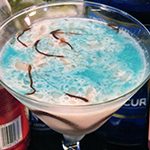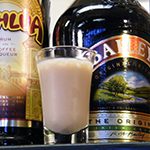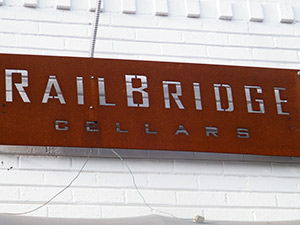 Recently, I had a chance to sit down with the Brand Manager of Rail Bridge Cellars, Michael Chandler. During our discussion, Michael explained to me the history of Rail Bridge, Some key decisions the winery has made recently, and where they are headed to in the next few years.
Recently, I had a chance to sit down with the Brand Manager of Rail Bridge Cellars, Michael Chandler. During our discussion, Michael explained to me the history of Rail Bridge, Some key decisions the winery has made recently, and where they are headed to in the next few years.
Atop the Elks Tower, at 11th and J Street in downtown Sacramento, we have a perfect view of the city. Since it’s Second Saturday, the penthouse floor has Speakeasy Saturday in full swing, and after our interview, a senior prom is being held on the second floor. We see Managing Partner of Rail Bridge, Michael Gelber, pop in to look around for a minute, and Chandler begins telling me the whole story of Rail Bridge Cellars.
Sacramento’s Original Urban Winery
Rail Bridge was actually the first urban winery in Sacramento, opening on North 16th Street in 2004. Michael Gelber ended up buying the winery from the original investment group in 2011, moving the tasting room to the Elks Tower location. The next move was to expand the wine production from two varieties to a more balanced number, between twelve and fourteen.
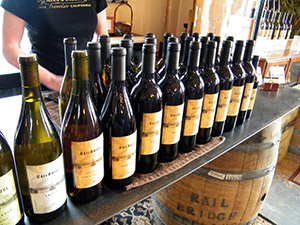 The growth of any urban winery is dependent on the ability to get grapes from suppliers. Chandler explains, “People think it’s easy being an urban winery, but it’s really not. We have to drive all the way to Napa to get our grapes, where if we were based in Napa County, we could look across the road and the grapes are right there.” Because of this, growth has to be throttled at a pace that allows smaller wineries to distribute consistently. Like Revolution Wines, Rail Bridge Cellars isn’t distributed to large retail chains like Safeway or BelAir. “Just Nugget, Whole Foods, Corti Brothers, the Co-op, that’s it”. Along with selected family-owned restaurants where they have by-the-glass deals, the only other way to buy Rail Bridge wines is direct, from their Elks Tower headquarters.
The growth of any urban winery is dependent on the ability to get grapes from suppliers. Chandler explains, “People think it’s easy being an urban winery, but it’s really not. We have to drive all the way to Napa to get our grapes, where if we were based in Napa County, we could look across the road and the grapes are right there.” Because of this, growth has to be throttled at a pace that allows smaller wineries to distribute consistently. Like Revolution Wines, Rail Bridge Cellars isn’t distributed to large retail chains like Safeway or BelAir. “Just Nugget, Whole Foods, Corti Brothers, the Co-op, that’s it”. Along with selected family-owned restaurants where they have by-the-glass deals, the only other way to buy Rail Bridge wines is direct, from their Elks Tower headquarters.
“[Grape] Production hasn’t been there last couple of years. We have handshake deals with our suppliers–they tell us, we can’t give you any fruit because we barely have enough for our big winery contracts. And what is there is just kind of eh. But we make it work. This year should be a lot better [for grape supplies].”
Michael is involved in every aspect of the wine production, and he explains how Rail Bridge makes adjustments each year.
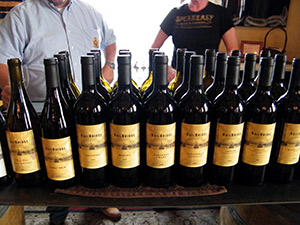 “First year, I made it for how I like to drink it, but it isn’t always about what you want. I made it a little fatter, and we sold 2011 twice as fast as we did 2010. Wine making, at it’s core, is science and chemistry.” There’s much more to making great wine than that, however.
“First year, I made it for how I like to drink it, but it isn’t always about what you want. I made it a little fatter, and we sold 2011 twice as fast as we did 2010. Wine making, at it’s core, is science and chemistry.” There’s much more to making great wine than that, however.
Becoming a Sommelier
After spending many years working in every possible role in the wine and restaurant steward industry, Chandler became one of only a handful of Sommeliers certified by the Court of Sommeliers, based on London. Michael is currently a Level 2 Sommelier (Level 4 is the highest level; less than 150 people have ever achieved this level). He is currently studying for the next level when he has time. The process for becoming a certified sommelier sounds crazy to me, and Chandler tells me that only 18% of people even pass the certification.
“They just put a glass of wine in front of you, it could be from anywhere in the world. And you have to know the type, the year, the region, the vineyard, the grape. The color is a big clue.” Chandler also says it bothers him when people say they are a sommelier, and they haven’t gone through the training or certification process, but instead just give themselves the title.
For those of you who of are still confused as to what a sommelier is, I was too. Think of a sommelier as a person who understand all aspects of wine production and serving. They know what foods pair well with each wine; they are able to make the best recommendation for each individual patron based on their taste and budget. In many cases, they are also in extremely knowledgeable about beer, spirits, and cigars. In short, they are in touch with all the subtle interactions between and the wines and every other aspect of the dining experience, and often run the entire restaurant floor.
Speakeasy Saturdays and the Penthouse Lounge
I ask how the Speakeasy Saturdays got started at the Penthouse Lounge. As everything great usually does, it starts with one amazing night that just keeps rolling.
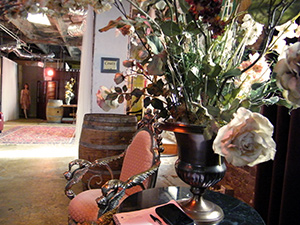 “We catered an event in this building, a speakeasy party a couple of years ago–people had to walk into the basement, like it was in Prohibition days. A lot of people don’t know, but that’s where the Elks had their gym, was in the basement. There were people hired to be in costumes: dressed as cops, and as bums, with a person at the door, with an eyehole slider to see if you were OK to let in. It was a big hit. I just threw a table top on top of the wine barrels and said, That’s my bar.”
“We catered an event in this building, a speakeasy party a couple of years ago–people had to walk into the basement, like it was in Prohibition days. A lot of people don’t know, but that’s where the Elks had their gym, was in the basement. There were people hired to be in costumes: dressed as cops, and as bums, with a person at the door, with an eyehole slider to see if you were OK to let in. It was a big hit. I just threw a table top on top of the wine barrels and said, That’s my bar.”
So was it a conscious decision to line up the [Penthouse Lounge] Speakeasy Saturdays with Second Saturday?
“We talked about it a lot; we were going to do 1st and 3rd Saturdays.” Chandler says. “At first, we were going to do it Thursdays but when we looked at the bookings, it was four weeks a month. So we said, we’re going to do it Fridays, but they were booked 3 out of 4 weeks every month. So finally we said, we’re just going to make it Saturday.”
“In the last couple of years, many art galleries downtown have closed, people we know, but the thing we noticed is that people are were in that habit of just going out and drinking, not really buying any art, just in and out.There was another city I lived in, every Third Thursday, it was the Farmers Market, and you just knew, Third Thursday.”
“Plus there’s a cadence to it, it just rolls off the tongue.”, I add. We laugh.
The Penthouse Lounge
“The mayor used to come up here a lot, not so much lately, he’s been busy. The Maloofs had a few meetings up here, where no one would be able to listen in, but that was on neutral ground”not at Arco [Arena] and not somewhere else…”
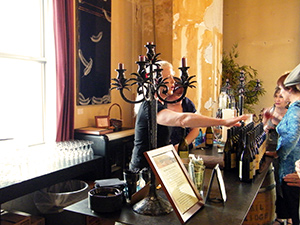 Chandler tells me as far as the Penthouse Lounge is concerned, Rail Bridge would like to make it a thing where people know it is happening, get it up to 2–3 nights a week. They host and cater events such as weddings all the time. He tells me a great story about how another wine company rented out the penthouse floor so that their staff could just relax and get toasted themselves for a change. Michael also tells me that the catering portion of their enterprise is also a large part of their growth.
Chandler tells me as far as the Penthouse Lounge is concerned, Rail Bridge would like to make it a thing where people know it is happening, get it up to 2–3 nights a week. They host and cater events such as weddings all the time. He tells me a great story about how another wine company rented out the penthouse floor so that their staff could just relax and get toasted themselves for a change. Michael also tells me that the catering portion of their enterprise is also a large part of their growth.
“We know the building, other caterers don’t. There’s no ovens, so they have to cook something somewhere else and bring it in.”
History of the Elks Tower
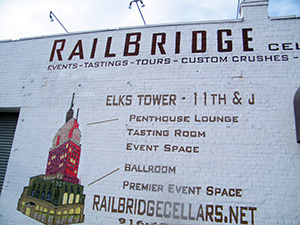 One of the big moves that Rail Bridge Cellars made early on was moving production from the old industrial location north of Alkali Flats to the Elks Tower. It turns out that the father-in-law of Rail Bridge leader Michael Gelber is the Elks Tower owner, Steve Ayers. We run in to him after the interview is over.
One of the big moves that Rail Bridge Cellars made early on was moving production from the old industrial location north of Alkali Flats to the Elks Tower. It turns out that the father-in-law of Rail Bridge leader Michael Gelber is the Elks Tower owner, Steve Ayers. We run in to him after the interview is over.
“He’s the most down-to-earth guy”, Chandler tells me.
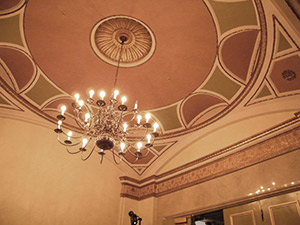 Elks Tower was a big deal back in the day, and even with the slow pace of interior restoration, the Tower showcases the old style of architecture that shows incredible attention to detail. Chandler tells me about the history of the building. Sacramento had wanted the Elks to build it since the 1880s, but the main branch of the Elks wouldn’t, “because that was still the Wild West, we were just a bunch of cowboys.” The Elks Tower wasn’t built until 1926, when they were in a race with another building to become tallest building in the city.
Elks Tower was a big deal back in the day, and even with the slow pace of interior restoration, the Tower showcases the old style of architecture that shows incredible attention to detail. Chandler tells me about the history of the building. Sacramento had wanted the Elks to build it since the 1880s, but the main branch of the Elks wouldn’t, “because that was still the Wild West, we were just a bunch of cowboys.” The Elks Tower wasn’t built until 1926, when they were in a race with another building to become tallest building in the city.
“They added the spire on top in order to be the tallest. It was built it in 1926 for a quarter million dollars. The Elks eventually sold it because they couldn’t keep up with the upkeep. Buzz Oates bought for quarter million dollars in 1957.”
“That’s depreciation.”
Chandler tells me about some of the plans that they have in store for the future, as well as some of the things they have done in the past.
 “Many of the renovations that are taking place today, we proposed 2 ½ years ago. Because it’s a historic building, everything has to be approved, right down to the doorknobs.
“Many of the renovations that are taking place today, we proposed 2 ½ years ago. Because it’s a historic building, everything has to be approved, right down to the doorknobs.
Buzz Oates would just do what he wanted and say, I’ll just pay the fine, but we’ve tried to do things the right way.”
He shows me where they are planning to open a new wine shop with food, and chilled wine closets. Building everything is a slow, steady march, as everything has to be built back exactly the way it was before. He explains the graffiti by the pools in the basement.
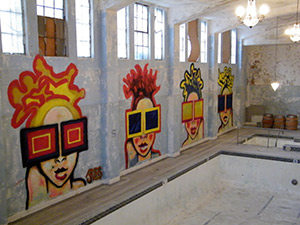 “We were having an event, with a DJ up top here, and we hired a graffiti guy from Carmel. He’s famous for doing girls faces with the square glasses, that’s like his trademark. We said, Do whatever you like, and that’s what he did.” Rail Bridge Cellars has a decade long history here in Sacramento, and they show no signs of slowing down anytime soon.
“We were having an event, with a DJ up top here, and we hired a graffiti guy from Carmel. He’s famous for doing girls faces with the square glasses, that’s like his trademark. We said, Do whatever you like, and that’s what he did.” Rail Bridge Cellars has a decade long history here in Sacramento, and they show no signs of slowing down anytime soon.
The Rail Bridge Cellars website.



